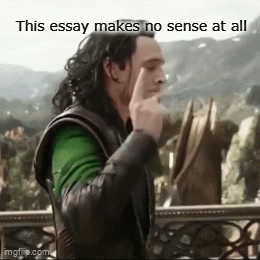Making It Easy to Understand: IELTS WRITING Task 2 (General Training and Academic)
- allroundtutor
- Mar 11, 2024
- 4 min read
Ahh, finally! Part 3 of the Making it Easy to Understand series has arrived! We can now focus on IELTS Writing Task 2.
The internet (and YouTube/TikTok) is full of well-meaning experts, teachers and learners themselves sharing everything they can find about IELTS but the only REAL way to know what is right is to head straight to the source.
So, you head to the source - which in this case is the IELTS website and YOU DO NOT UNDERSTAND what it all means because sometimes it just seems far too complicated. This series of blog entries will be titled “Making It Easy to Understand” and I will breakdown the key assessment criteria and explain what is expected of the candidate in the most simple, easy-to-understand language so that you can start preparing for IELTS the right way.
***Remember, there are no shortcuts, hacks, tips, tricks. It takes work, commitment and true effort to not just ace an IELTS test, but to improve your general command of English.***
Sources quoted below but a good amount of the details in this blog post will be found in my guidebook, The No BS Guide to Achieving IELTS Success. Head to the PIAPT online store if you're keen to purchase it: https://2fdcde-61.myshopify.com/products/ebook-the-no-bs-guide-to-achieving-ielts-success
One of the major issues I have found with students is that they just don't seem to understand why, despite their great efforts, fancy vocabulary and attempts at complex grammar, they don't achieve high band scores. Here's why: they don't understand the key assessment criteria for Task 2 Writing!
So, let’s break it down into simple sections and then discuss each one!
What are the 4 criteria that are used to mark IELTS Writing Task 2? Put simply:
Task Response - In IELTS Writing Task 1, the first key assessment criteria is called "Task Achievement". In Task 2, this is changed to "Task Response". Why? The difference lies in the essays that are written. Task 1 questions for both GT and Academic require a standardized, predictable answer in the form of a report/letter while Task 2 questions require a thought-out response in the form of an essay. Hence, Task Response.
All 3, (GT Task 1, Academic Task 1 and GT/Academic Task 2) have BASIC FORMATS YOU MUST FOLLOW. GT Task 1 requires a letter of no less than 150 words, Academic Task 1 requires a report of no less than 150 words and finally Task 2 for both require a 250 word-long formal essay.

Task Response: What is really expected of you? Candidates are expected to
Wow! So much easier said than done, right? Wrong. It is easy, you just have to follow the rules! We'll get to the rules in another post but for now all you need to know is that you
need to write/type an essay of approximately 250 words
which directly answers the question in the form of a response to a statement.
The essay must be in a standard formal essay format (Introduction - Body paragraphs - Conclusion) and
the ideas must be directly relevant to the question/statement.

Moving on! Coherence and Cohesion! Gosh, this one drives examiners crazy! Let me break is down for you:
PARAGRAPHS. USE THEM. No one wants to read one giant, continuous text! A collection of bullet points is NOT an essay! Write about 4-5 well structured paragraphs.
LOGIC. Like common sense, logic goes out the window when it comes to Task 2 writing. As with all formal essays, each paragraph needs to have a topic sentence and then an explanation/expansion/examples.
Once the point has been made, another point can be introduced in ANOTHER PARAGRAPH! Each paragraph should contain just one central point (which is made clear to the reader in the topic sentence) and each paragraph needs to "flow" and be linked to the former paragraph.
Essentially, what examiners want is a complete essay: 1 Introduction - Up to 3 Body Paragraphs - 1 Conclusion which progresses clearly and is easy to understand.
Remember that you are writing an essay for someone else to read! If you don't understand your own writing, you cannot expect an IELTS examiner to as well. Keep it clear, easy to understand, logical and flowing smoothly and you will have a very high band score for Coherence and Cohesion.
Now let’s move onto Lexical Resource
Basically: VOCABULARY! Use the right words and use them well. Try not to repeat yourself too much, don’t make spelling mistakes and Voila! High band scores for everyone! Easier said than done - I know - but that’s basically all there is to it.
Finally, Grammatical Range and Accuracy
Basically: Write good sentences. Write different types of sentences; simple, compound and complex. Write them well and again, VOILA! High band scores for everyone!
You will find that 2 of these criteria are IELTS SPECIFIC (required and predictable format) and the other 2 strongly connected to general command of the language. You could argue that Coherence and Cohesion is also strongly connected to academic essay writing in general but for the sake of all IELTS students, let’s keep it simple and say C & C is IELTS specific!
This means that test takers must work on BOTH! Preparation for IELTS goes hand in hand with general improvement in your command of the language.
I hope this has simplified and made Key Assessment Criteria for IELTS Writing Task 2 (both GT and Academic) easier to understand. Now you know:
· What is expected of you.
· How you are going to be scored for each criteria
· What needs to be done to get a high score (very simplified, I know, but that’s where your tutor/mentor/course providers come in and help!)
Keep checking back for more in the “Making It Easy to Understand” series!
Love,
Reena
[Sources: https://s3.eu-west-2.amazonaws.com/ielts-web-static/production/Guides/ielts-writing-key-assessment-criteria.pdf and https://s3.eu-west-2.amazonaws.com/ielts-web-static/production/Guides/ielts-writing-band-descriptors.pdf ]











Comments